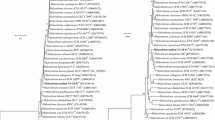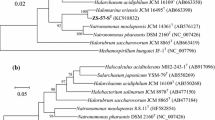Abstract
Halophilic archaeal strain XD48T was isolated from a Chinese marine solar saltern. Cells were pleomorphic, stained Gram-negative and formed red-pigmented colonies on solid media. Strain XD48T was found to be able to grow at 25–50 °C (optimum 37 °C), at 0.9–4.8 M NaCl (optimum 3.1 M NaCl), at 0–1.0 M MgCl2 (optimum 0.3 MgCl2) and at pH 5.0–9.5 (optimum pH 6.5). The cells lysed in distilled water, and the minimal NaCl concentration to prevent cell lysis was found to be 5 % (w/v). The major polar lipids of the strain were phosphatidic acid (PA), phosphatidylglycerol (PG), phosphatidylglycerol phosphate methyl ester (PGP-Me), phosphatidylglycerol sulfate (PGS), sulfated galactosyl mannosyl glucosyl diether (S-TGD-1), sulfated mannosyl glucosyl diether (S-DGD-1) and six unknown glycolipids. The 16S rRNA gene and rpoB′ gene of strain XD48T were phylogenetically related to the corresponding genes of Haloarchaeobius members (92.4–93.9 and 89.6–90.5 % similarities, respectively). The DNA G + C content of strain XD48T was determined to be 65.3 mol%. The phenotypic, chemotaxonomic and phylogenetic properties suggested that strain XD48T (=CGMCC 1.12230T = JCM 18642T) represents a new species of Haloarchaeobius, for which the name Haloarchaeobius amylolyticus sp. nov. is proposed.

Similar content being viewed by others
References
Cui H-L, Qiu X-X (2014) Salinarubrum litoreum gen. nov., sp. nov.: a new member of the family Halobacteriaceae isolated from Chinese marine solar salterns. Antonie Van Leeuwenhoek 105:135–141
Cui H-L, Zhou P-J, Oren A, Liu S-J (2009) Intraspecific polymorphism of 16S rRNA genes in two halophilic archaeal genera, Haloarcula and Halomicrobium. Extremophiles 13:31–37
Cui H-L, Gao X, Yang X, Xu X-W (2010) Halorussus rarus gen. nov., sp. nov., a new member of the family Halobacteriaceae isolated from a marine solar saltern. Extremophiles 14:493–499
Cui H-L, Yang X, Mou Y-Z (2011) Salinarchaeum laminariae gen. nov., sp. nov.: a new member of the family Halobacteriaceae isolated from salted brown alga Laminaria. Extremophiles 15:625–631
Kim M, Oh H-S, Park S-C, Chun J (2014) Towards a taxonomic coherence between average nucleotide identity and 16S rRNA gene sequence similarity for species demarcation of prokaryotes. Int J Syst Evol Microbiol 64:346–351
Makhdoumi-Kakhki A, Amoozegar MA, Bagheri M, Ramezani M, Ventosa A (2012) Haloarchaeobius iranensis gen. nov., sp. nov., an extremely halophilic archaeon isolated from a saline lake. Int J Syst Evol Microbiol 62:1021–1026
Marmur J, Doty P (1962) Determination of the base composition of deoxyribonucleic acid from its thermal denaturation temperature. J Mol Biol 5:109–118
Meier-Kolthoff JP, Göker M, Spröer C, Klenk H-P (2013) When should a DDH experiment be mandatory in microbial taxonomy? Arch Microbiol 195:413–418
Minegishi H, Kamekura M, Itoh T, Echigo A, Usami R, Hashimoto T (2010) Further refinement of Halobacteriaceae phylogeny based on the full-length RNA polymerase subunit B’ (rpoB ’) gene. Int J Syst Evol Microbiol 60:2398–2408
Oren A (2012) Taxonomy of the family Halobacteriaceae: a paradigm for changing concepts in prokaryote systematics. Int J Syst Evol Microbiol 62:263–271
Oren A (2014) Taxonomy of halophilic Archaea: current status and future challenges. Extremophiles 18:825–834
Oren A, Ventosa A, Grant WD (1997) Proposed minimal standards for description of new taxa in the order Halobacteriales. Int J Syst Bacteriol 47:233–238
Oren A, Arahal DR, Ventosa A (2009) Emended descriptions of genera of the family Halobacteriaceae. Int J Syst Evol Microbiol 59:637–642
Owen RJ, Pitcher D (1985) Current methods for estimating DNA base composition and levels of DNA-DNA hybridization. In: Goodfellow M, Minnikin DE (eds) Chemical methods in bacterial systematics. Academic Press, London, pp 67–93
Stackebrandt E, Goebel BM (1994) Taxonomic note: a place for DNA-DNA reassociation and 16S rRNA sequence analysis in the present species definition in bacteriology. Int J Syst Bacteriol 44:846–849
Tamura K, Peterson D, Peterson N, Stecher G, Nei M, Kumar S (2011) MEGA5: molecular evolutionary genetics analysis using maximum likelihood, evolutionary distance, and maximum parsimony methods. Mol Biol Evol 28:2731–2739
Yuan P-P, Zhang W-J, Han D, Cui H-L (2015) Haloarchaeobius salinus sp. nov., isolated from an inland salt lake of China. Int J Syst Evol Microbiol 65:910–914
Zhang W-J, Cui H-L (2014) Haloarchaeobius litoreus sp. nov., isolated from a marine solar saltern. Antonie Van Leeuwenhoek 105:1085–1090
Acknowledgments
This work was supported by the National Natural Science Foundation of China (No. 31370054), the 11th “Six Talents Peak” Project of Jiangsu Province (No. 2014-SWYY-021), the Qinglan Project of Jiangsu Province and a project funded by the Priority Academic Program Development of Jiangsu Higher Education Institutions (PAPD).
Author information
Authors and Affiliations
Corresponding author
Additional information
Communicated by Harald Huber.
Electronic supplementary material
Below is the link to the electronic supplementary material.
203_2015_1129_MOESM1_ESM.doc
Phase-contrast micrograph of strain XD48T, thin-layer chromatograms of polar lipids of strain XD48T and some related haloarchaea, neighbor- joining phylogenetic tree reconstructions based on 16S rRNA gene and rpoB′ gene sequences showing the relationships between strain XD48T and related members within the family Halobacteriaceae are available as supplementary materials. (DOC 637 kb)
Rights and permissions
About this article
Cite this article
Yuan, PP., Sun, XJ., Liang, X. et al. Haloarchaeobius amylolyticus sp. nov., isolated from a marine solar saltern. Arch Microbiol 197, 949–953 (2015). https://doi.org/10.1007/s00203-015-1129-9
Received:
Revised:
Accepted:
Published:
Issue Date:
DOI: https://doi.org/10.1007/s00203-015-1129-9




